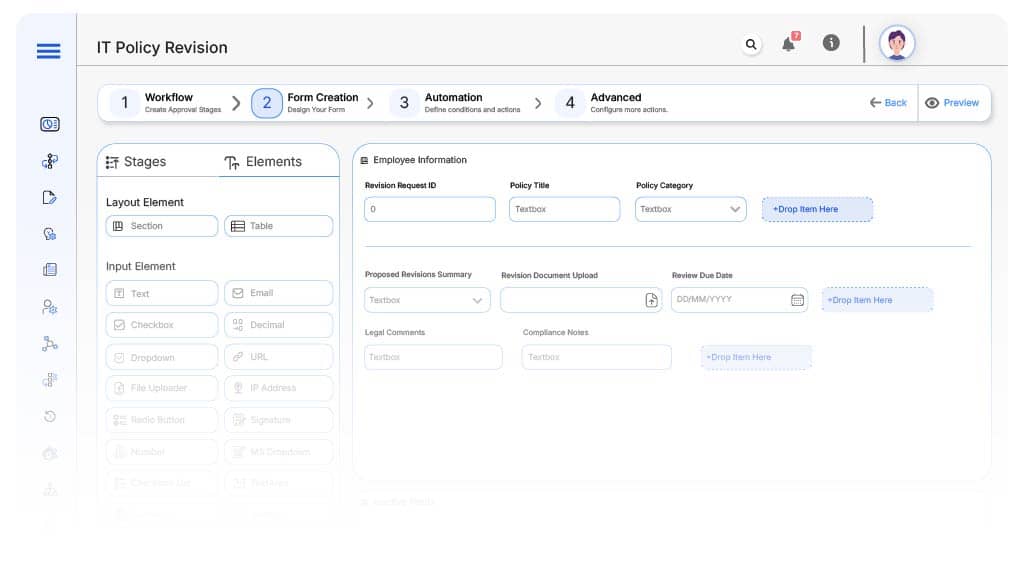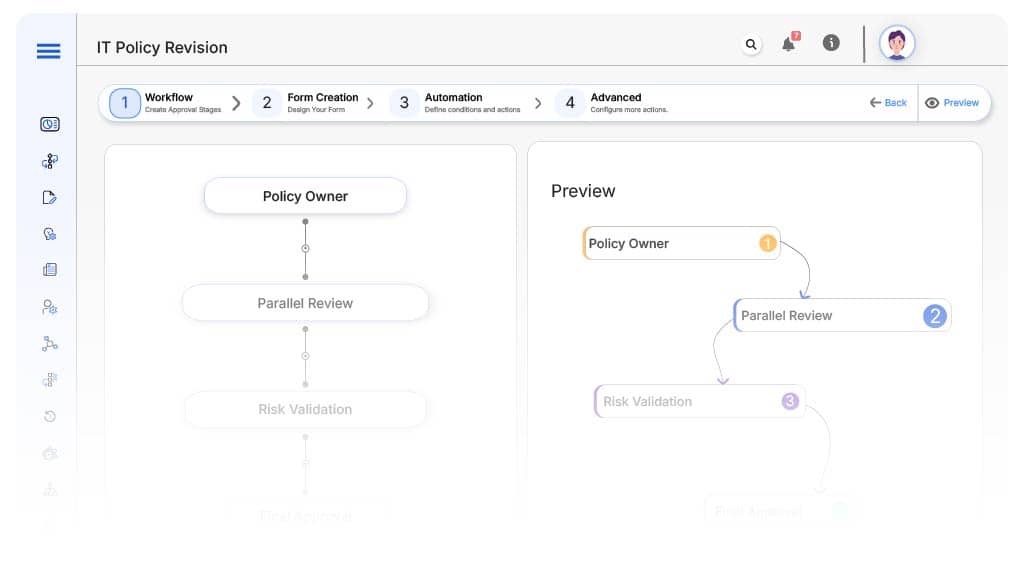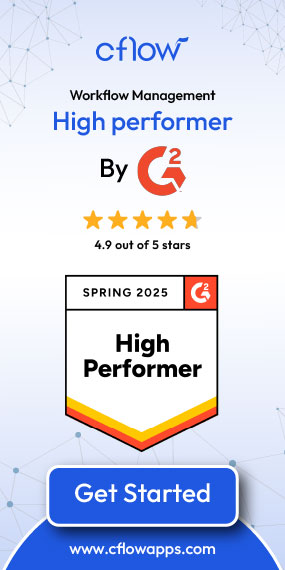- Cflow
- IT Policy Revision Automation
IT Policy Revision Automation

Clow Team

The IT Policy Revision Process is a critical governance workflow that ensures an organization’s security and compliance protocols remain current and enforceable. Without automation, this process is slow, error-prone, and often lost in email threads and static documents. Recent compliance studies indicate that 42% of policy violations occur due to outdated or unreviewed IT policies.
Manual coordination across IT, Legal, Compliance, and HR leads to version conflicts, missed deadlines, and audit risks. This guide walks you through exactly how Cflow automates the IT Policy Revision Process, from review initiation to publishing and archival.
What Is IT Policy Revision Process?
The IT Policy Revision Process governs how existing IT policies are reviewed, updated, approved, and disseminated across the organization. It coordinates multiple teams including IT, Legal, Compliance, and Security to maintain policy integrity.
Think of policy revision like maintaining a fleet of aircraft—you must inspect and update systems regularly or risk operational failure. Without structured workflows, revisions get delayed or missed, creating gaps in protection and compliance.
Recent governance audits show that companies with automated policy management reduce policy update time by 60% and improve audit readiness by over 45%.
Why IT Policy Revision Process Is Important for IT Teams
Risk Mitigation
Audit Preparedness
Regulatory Compliance
Cross-Functional Visibility
Key Benefits of Automating IT Policy Revision Process with Cflow
- Centralized Policy Review Console: Cflow offers a single portal where IT, Legal, and Compliance teams track the status of all policy revisions. Every change request, draft edit, reviewer feedback, and approval is logged in real time, avoiding scattered email trails and version confusion.
- Automated Revision Cycles: Cflow supports scheduled review intervals (quarterly, biannually, annually) to ensure policies never go stale. Admins can set automatic triggers based on expiration dates or compliance requirements, ensuring timely reviews without manual reminders.
- Parallel Review Workflows: Rather than wait for sequential feedback, Cflow allows Legal, Compliance, and Security reviewers to collaborate in parallel. Smart notifications prompt users, and policy progression is blocked until all mandatory inputs are submitted.
- Version Control & Document Archival: Each new draft is versioned and archived. Cflow stores a complete change history, who edited what, and when, making audit preparation effortless. Final policies are pushed to a central knowledge base with read-only access.
- Escalation Management & Delays Prevention: If tasks are overdue, Cflow automatically escalates them to supervisors or policy owners. Reviewers receive follow-up alerts, ensuring no policy revision falls through the cracks.
- Policy Publishing Workflow: Once approved, final policies are published to employee portals or compliance repositories with version stamps and revision dates. Everyone accesses the latest version without confusion.
- Audit Logs & Compliance Reporting: Cflow logs every action, comment, edit, approval, or rejection. These logs are exportable as audit-ready reports that meet requirements for SOC 2, ISO 27001, or internal IT audits.
- Mobile-Ready Review Interface: Legal teams, IT leads, and compliance officers can review and comment on policy revisions directly from mobile devices. Cflow ensures deadlines are met, even while working remotely or traveling.
Get the best value for money with Cflow
User Roles & Permissions
Policy Owner
- Responsibilities: Initiate revisions, draft changes, manage lifecycle
- Cflow Permission Level: Admin
- Mapping: “IT Policy Owners” group
Legal Reviewer
- Responsibilities: Review legal language, regulatory alignment
- Cflow Permission Level: Approve/Reject
- Mapping: “Legal Team” group
Compliance Officer
- Responsibilities: Confirm policy meets compliance frameworks
- Cflow Permission Level: Approve/Reject
- Mapping: “Compliance” group
Security Officer
- Responsibilities: Validate technical accuracy and risk controls
- Cflow Permission Level: Task Owner
- Mapping: “Security” group
Executive Approver
- Responsibilities: Sign off on final draft (e.g., CIO, CTO)
- Cflow Permission Level: Approve
- Mapping: “Leadership” group
Auditor
- Responsibilities: View audit trails and version history
- Cflow Permission Level: View Only
- Mapping: “Audit Team” group
Discover why teams choose Cflow
Form Design & Field Definitions

Field Label: Revision Request ID
- Type: Autonumber
- Auto-Populate: Generated on submission.
Field Label: Policy Title
- Type: Text (Read-only)
- Auto-Populate: Pulled from Policy Register
Field Label: Policy Category
- Type: Dropdown (Access Control, Data Retention, BYOD, etc.)
- Logic/Rules: Drives routing
Field Label: Proposed Revisions Summary
- Type: Long Text
- Logic/Rules: Required
Field Label: Revision Document Upload
- Type: File Upload
- Logic/Rules: Required for Legal and Compliance review
Field Label: Review Due Date
- Type: Date Picker
- Logic/Rules: Required
Field Label: Legal Comments
- Type: Text Area
- Logic/Rules: Required for Legal Reviewer
Field Label: Compliance Notes
- Type: Text Area
- Logic/Rules: Required for Compliance Officer
Field Label: Risk Classification
- Type: Dropdown (Low, Medium, High)
- Logic/Rules: Triggers executive approval if High
Field Label: Final Approval
- Type: Checkbox
- Logic/Rules: Required before publishing
Field Label: Published Version URL
- Type: Text
- Auto-Populate: From document repository
Transform your Workflow with AI fusion
Approval Flow & Routing Logic

Submission → Policy Owner
- Status Name: Pending Draft Creation
- Notification Template: “New revision initiated for {Policy Title}. Please upload draft and submit.”
- On Approve: Routes to Legal and Compliance reviewers in parallel
Legal + Compliance → Parallel Review
- Status Name: Pending Legal & Compliance Review
- Notification Template: “Please review updated draft for {Policy Title} by {Due Date}.”
- On Approve: Routes to Security Officer
- Escalation: Reminder after 3 days
Security Officer → Risk Validation
- Status Name: Pending Security Review
- Notification Template: “Validate technical changes for {Policy Title}.”
- On Complete : If Risk = High → Routes to Executive Approval; If Risk ≠ High → Routes to Publishing
Publishing → Final Archive
- Status Name: Published
- Notification Template: “Policy revision for {Policy Title} published. Version archived.”
- On Complete: Routes to Final Sign-Off
Final → Policy Revision Complete
- Status Name: Policy Revision Complete
- Notification Template: “Policy update for {Policy Title} is complete and archived. Workflow closed.”
- On Complete: Audit log saved, version published, and all stakeholders notified
Transform your AI-powered approvals
Implementation Steps in Cflow
Create a new workflow
Design the form
Set up User Roles/Groups
Build the process flow diagram
Configure notifications
Set conditional logic
Save and publish workflow
Test with a sample request
Adjust logic if needed
Go live
Example Journey: Cloud Policy Update
FAQ's
Unleash the full potential of your AI-powered Workflow

